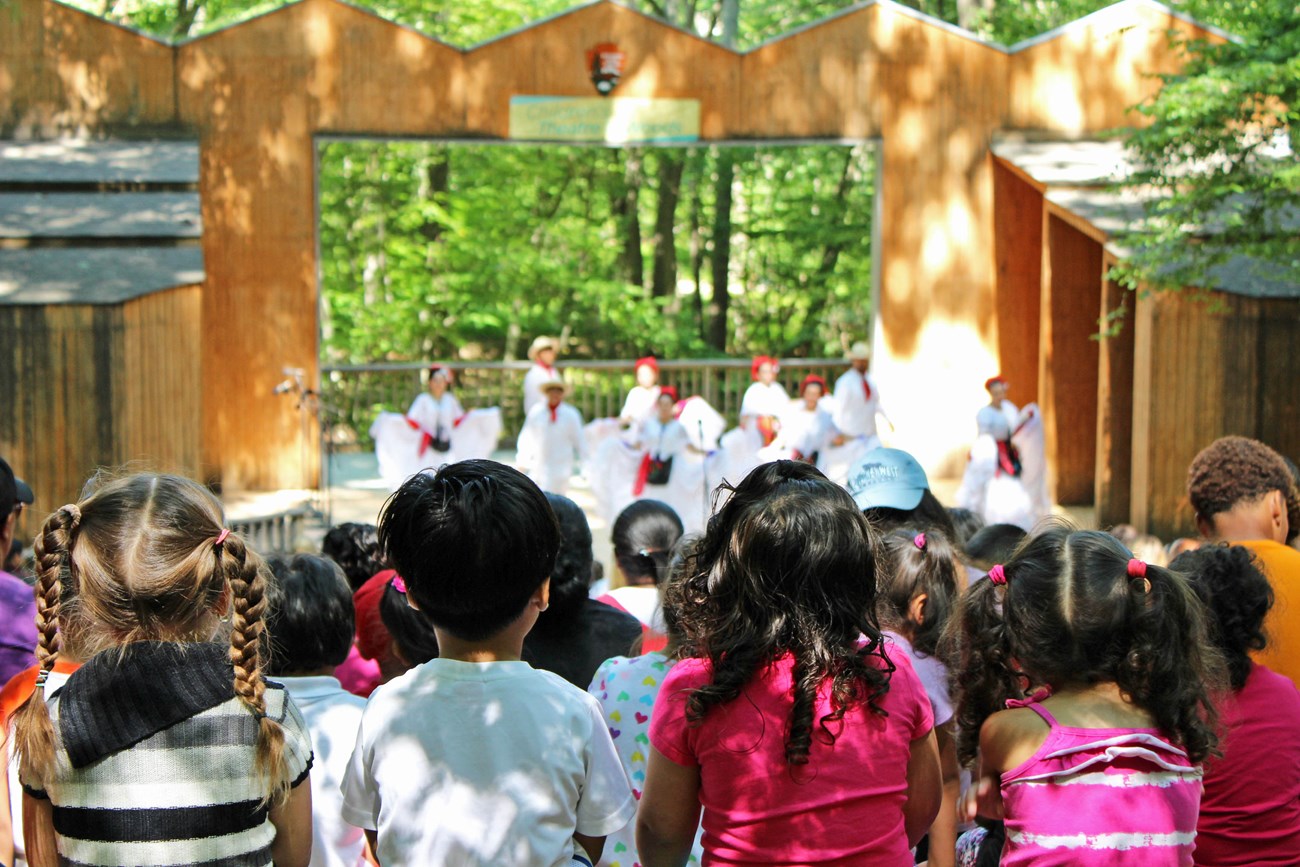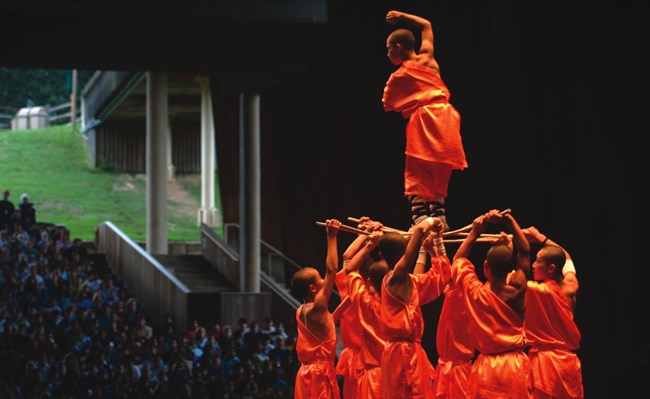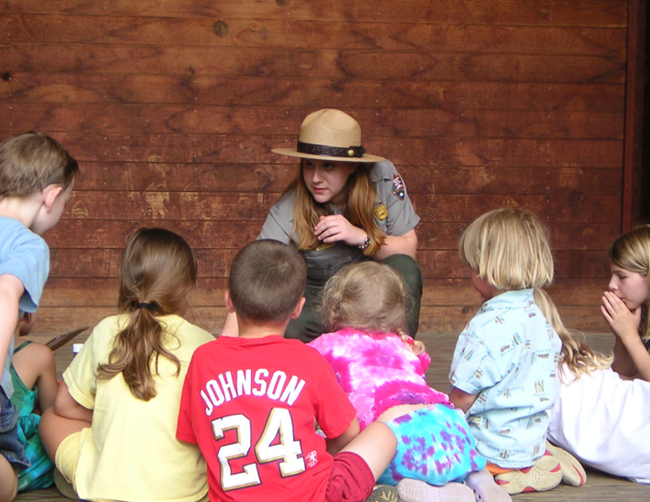
NPS

COURTESY OF ARTSFAIRFAX, previously Arts Council of Fairfax County International Children’s Festival: 1971-2010In addition to providing arts education to children, Wolf Trap National Park also worked to support children within performing arts communities. This began in 1971 when the park was one of the sponsors for the first International Children’s Day. This was a one-day event that featured four shows, crafts and demonstrations, as well as a children’s musical on the Filene Center stage. Many acts featured young performers. Programing during the event focused on introducing multicultural performing arts to children and families from low-income areas in the Washington DC metropolitan area. Transportation was provided through company-sponsored busses to support a larger population of families. Due to the popularity of the event, it was extended to two days in 1972 and in 1974 the program was expanded to the International Children’s Festival (ICF). The ICF was a weekend festival and included two days of programming for local schools that continued to focus on international arts performances. Many of the performers were between the ages of 6 and 19, emphasizing the experience and connection between children and the performing arts, as well as supporting young performers. The festival quickly became a staple program offered at Wolf Trap with 20,000 to 35,000 people attending the festival each year it was offered. Conflicts between the scheduling of standard Filene Center productions and the evening use of the stage for ICF performances resulted in an agreement (1994) whereby the festival was scheduled only on weekends and was moved to late September. In 1995, an agreement with the Fairfax County Public School System expanded the ICF to Tuesday through Friday for fifth graders in the county. Children were transported to the park by bus for a 90-minute showcase of the weekend’s performances. Annually, around 11,000 Fairfax County fifth graders attended the weekday showcase. The weekday program was shortened to three days in 2009, and in the spring of 2010 the Fairfax County Board of Education cut the transportation budget. This affected the festival budget because the ICF relied on those funds to operate the program and pay stagehands. Unable to pay those costs, the ICF was moved to the meadow in 2010. The festival was also limited to the weekend and did not feature international performers, one of its original draws. In December 2010, the ICF ended following its 40th annual event due to funding limitations. The festival has not been reinstated or replaced in the park’s programming. Chapter I Festival: 1980-2008The second festival-style programming offered at the park was the Chapter I Festival. It premiered in 1980 and was a weeklong event designed to correspond with the Chapter I federal funding program under the Education Consolidation and Improvement Act (1981). Chapter I provides schools in low-income areas with more funding to support education initiatives. Funds from the program were used to cover the transportation costs, which allowed lower-income children to attend the festival. This included schools in Montgomery County and enabled students to be bussed to the park for the day’s activities. While the Chapter I funds paid for transportation and lunches, donations acquired by the park staff paid for the performers, though some performers volunteered their time. Several thousand children attended the festival each year, initially between 5,000 and 7,000. The festival was first held at the Children’s Theatre-in-the-Woods and Concert Shell but was later expanded to the Filene Center as attendance increased to more than 10,000 each year. The Chapter I Festival was canceled in 2008 due to scheduling conflicts resulting from turnover of the Chapter I Coordinator position in the Montgomery County school system. Transportation plans for the school year were not submitted on time and as a result no funding was given. Without the additional funding the school system could no longer afford transportation to the park and the program came to an end. Theatre-in-the-WoodsOf the park’s original children’s programming, the Children’s Theatre-in-the-Woods is the only program still presented today. In 1972 the NPS organized and launched the Children’s Theatre-in-the-Woods program, which offered daytime performing arts programs free of charge to children and their families. The programing included opera-oriented puppet shows, concerts by the National Symphony Orchestra, and dance programs by the Harkness Youth Ballet. In 1973, NPS maintenance personnel and volunteers constructed the Children’s Theatre-in-the-Woods. This was a small-scale production stage located to the northeast of the Filene Center. Unfortunately, a fire destroyed the theater in 1976. Due to the fundraising efforts of Mrs. Shouse and the Foundation, the construction of a new 750-person capacity theater was possible and opened in time for the 1977 season. Funding for the Children’s Theatre-in-the-Woods program was more challenging after the enactment of the Gramm-Rudman-Hollings Act (1986) that aimed to cut federal spending. This resulted in agency-wide budget cuts which impacted the park’s programming. By 1999, the park and Foundation entered into an agreement where the park remained responsible for the maintenance of the theater and the operation of the program, while the Foundation took over contracting and scheduling of performers. To offset booking costs, the Foundation instituted a ticket fee for performances which is still in place today. While these initial challenges required the park to adapt its structure and programming of the theater, the project is still a successful piece of Wolf Trap’s educational outreach to children. From their own website describing the theater: "The Children’s Theatre-in-the-Woods continues to host local, national, and even international performers, from Grammy Award-winning musicians to puppeteers to dancers of all kinds. It continues to bring the performing arts and the natural world to children and families, keeping Mrs. Shouse’s vision alive." 
NPS Additional ProgrammingWhile children’s programming such as the ICF and Chapter I Festival are no longer offered, Wolf Trap has continued to develop children’s programming. For instance, in 2003 the park’s first Junior Ranger program launched and is still offered today. The Wolf Trap Junior Ranger activity book is similar to books used in other national parks with activities that connect children to the subjects and landscape of the national park they are visiting. Wolf Trap’s program furthers children’s understanding of the performing arts and the natural environment of the park through scavenger hunts and art activities that can be completed at home or during a park visit. In 2007, the park held its first Junior Ranger Day, establishing a partnership with Wolf Trap Elementary School. Additionally, in 2005, the park’s education program was expanded to include two curriculum-based programs. These were specifically focused on educating children about natural resources found in the park. These programs were “Natural Sound for Kindergarteners” and “Watersheds for Sixth Graders,” which were developed in cooperation with Colvin Run Elementary School. Presently, other programs include different tours and fieldtrip opportunities that explore the technology and science behind the performing arts. Under park superintendent Karen Pittleman (2010-2015), Wolf Trap began to focus more on promoting year-round visitation and interpreting the park’s natural resources. Park Gardener Phil Goetkin, and volunteers from the Friends of Wolf Trap created several gardens to support and encourage biodiversity. One of these gardens in front of the Filene Center, sometimes known as the “dimple”, has more that 20,000 native plants. In the park’s educational programming the garden connects children to the performing arts in a natural setting—just as Catherine Filene Shouse intended. Learn MoreFor more information see Elder-Norquist E. 2021. Wolf Trap National Park for the Performing Arts Administrative History Update. Organization of American Historians for National Park Service. |
Last updated: January 5, 2024
